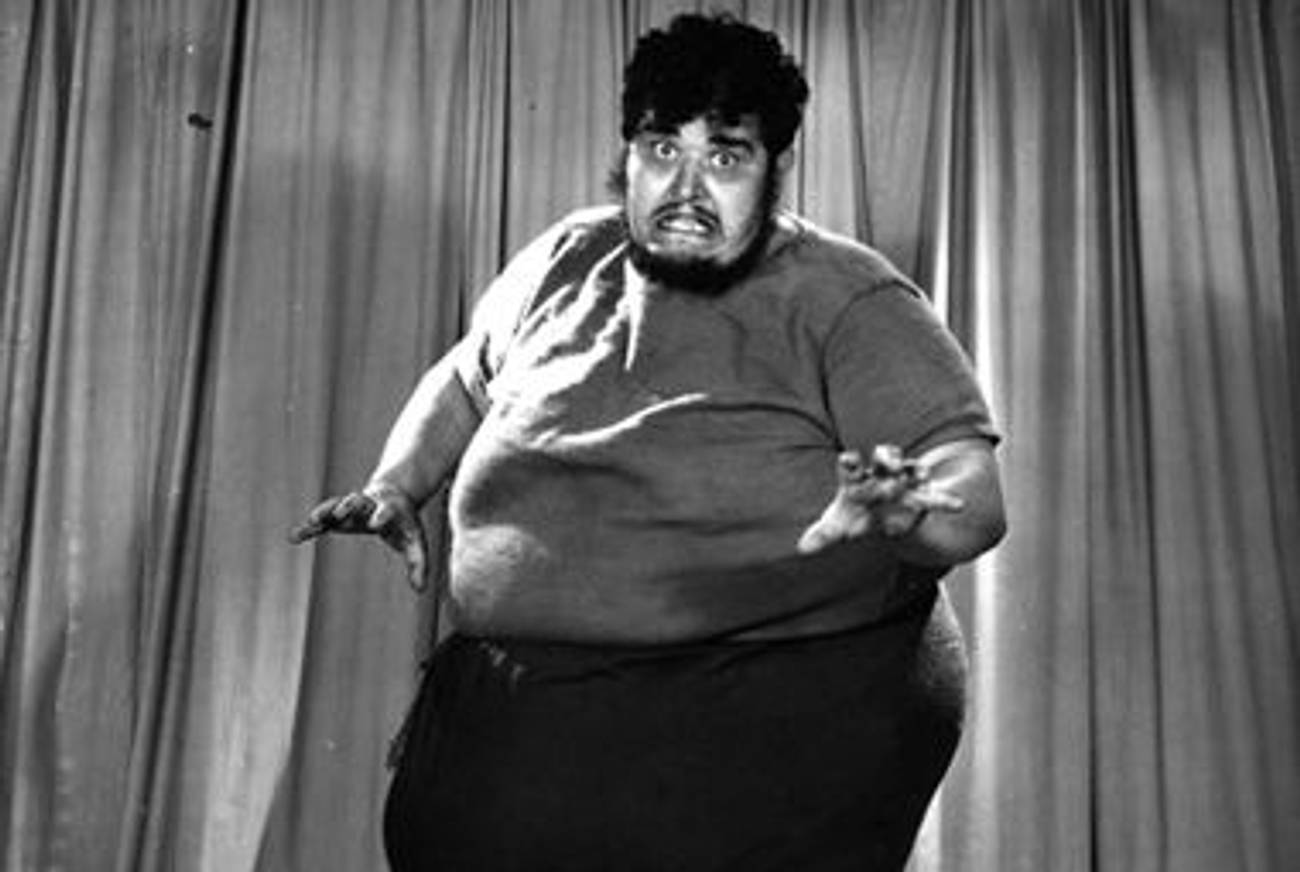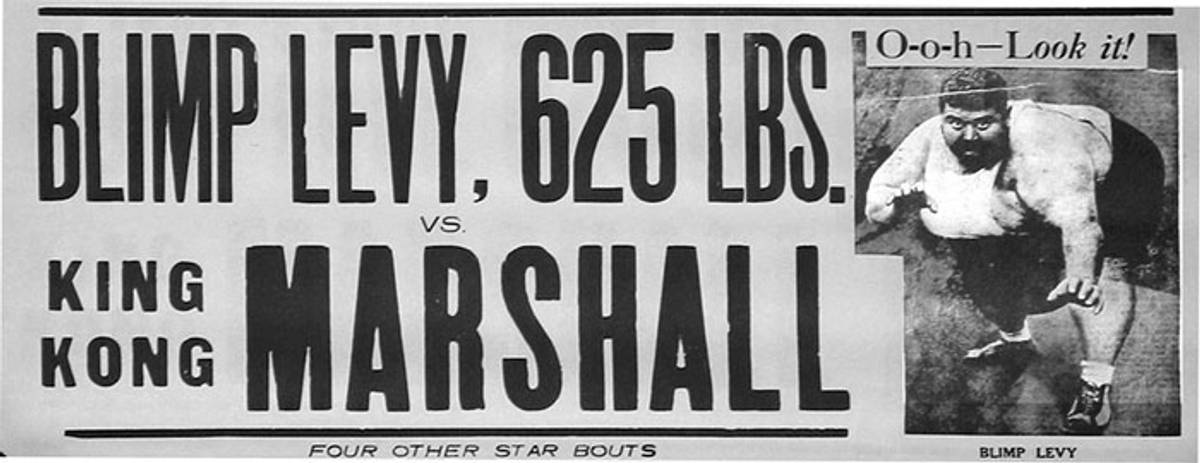Big Man
The Coney Island attraction who made wrestling history




The New York World-Telegram called Martin “the Blimp” Levy “the most meat which ever stepped into a ring.” Other papers used the “miniature mastadon” and the “Boston pachyderm.” Discovered in the mid-1930s working as the fat man in a Coney Island side show by wrestling impresario Jack Pfefer, Blimp tipped the scales somewhere between 600 and 700 pounds. Nobody knew exactly how much he weighed because normal scales couldn’t contain him. With the larger men in the mat game weighing in somewhere between 200 and 300 pounds, the morbidly obese Blimp, with his ample corpus and bug eyes, was one of the first freaks in professional wrestling.
But freaks were his manager’s specialty: Pfefer made wrestlers in his stable shave their heads or grow huge antennaed mustaches. He also brought in grapplers like the acromegalic Swedish Angel, christening him “the ugliest man in the world” and guaranteeing that ladies in the audience would faint, men would shout, and children would cry upon laying eyes on him.
Just as there was there was heavy Jewish participation in boxing during the early part of the 20th century, so too were there Jews in pro wrestling. Long before Bill Goldberg became the champ of the WWF in the late 1990s, Jewish toughs such as Harry “the Jewish Bad Boy” Finkelstein and Abie “Hebrew Hercules” Coleman were mixing it up in rings across the country, sporting Stars of David all the while.
Raised in Boston, Levy was a big boy from early on. He weighed 200 pounds at his bar mitzvah and was over 350 by the time he got to high school. He played football for a short time, but was asked to leave the team after falling on opponents and breaking the legs of several linesman. In a 1946 Washington Post interview, Blimp described his unusual dietary regimen: “Some mornings I eat a dozen eggs, and then again, sometimes only two. Sometimes I eat six pounds of steak, and then I might eat a pound.” He also admitted to going on an occasional mashed potato binge, requiring a half bushel of spuds, two quarts of milk, and a pound of butter.
In spite of his massive bulk, the Blimp was surprisingly nimble. Paul Boesch, one of the only wrestlers of the Golden Era of the 1930s and ’40s to write a cogent autobiography, wrote that his first impression of the Blimp was that he was simply a pituitary case who won his matches by falling on his opponents, immobilizing them with his enormity. That may be partly accurate. But Boesch noted that the Blimp suspected the other wrestlers considered him a no-talent fat man, and one day in a locker room, he was challenged to kick a small metal can which dangled from the ceiling about six feet off the ground. In an attempt to show off his athletic prowess, the Blimp gingerly approached the can, brought one of his monstrous, fleshy, tree trunk-like legs up high into the air and tapped it with his foot. The other wrestlers were amazed because they couldn’t do it themselves without falling on their asses. It became evident that Blimp Levy wasn’t a run-of-the-mill, morbidly obese wrestler: he had skill. He was, as his manager insisted, “a freak with class.”
Outside the ring, the Blimp was said to have a voracious sexual appetite and regaled peers with stories of his conquests. A kind of Semitic Pantagruel, he was characterized by Boesch as “a seething volcano of sexual passion.” While his conquests were not elaborated upon (thankfully, perhaps), the Blimp married multiple times, usually women far younger than he. In 1946, he wed 18-year-old Charlotte Jones, a woman half his age, in Dallas. A few years before that, 24-year-old-Juanita Thomas was so eager to get hitched to the Blimp that she neglected to obtain a divorce from her previous husband or to inform her newly betrothed that she had been married. This little fact came in handy when, in 1945, she tried to squeeze alimony payments out of poor Mr. Levy. Moreover, he testified in court—after having been shoehorned into the witness stand—that little Ms. Thomas physically abused him. In the end, the court had mercy on the Blimp and ruled against Juanita.

In spite of that victory, bad luck trailed the Blimp. In 1946, the Connecticut State Athletic Commission revoked his license on the recommendation of physicians, who said he was in poor health. Even his manager opined he was so fat that he would probably drop dead in the ring. But all was not lost; the Blimp wrestled abroad. In Malaysia, a Singapore-based promoter lined up Harnam Singh, Son of Kong, and the 6-foot-10-inch Da Ra Singh, among other famed South Asian behemoths, and offered the Blimp $2000 plus travel expenses and accommodations. But perhaps the most attractive clause in his contract had to do with an unlimited supply of food to throw his weight around the subcontinent for six months.
In spite of the mockery he endured, the Blimp was a pretty good wrestler. He defeated Tor Johnson, the Swedish Angel, and Nature Boy Buddy Rogers, names familiar to anyone who went to wrestling matches in the 1940s and 1950s.
But by the end of his career, around 1950, Blimp’s health truly did begin to fail. Astoundingly, the incidental exercise provided to him by his profession had helped him keep somewhat trim. When he quit wrestling and dropped from sight, he really ballooned. At his death in an Alabama trailer park at 56, Blimp weighed 900 pounds and had a 120-inch waistline. Take 10 steps, turn around and look at the spot where you started: that was the final measurement of Blimp Levy’s waist.
It may not seem so, but, in a certain time and place, Blimp Levy was famous, world famous. He performed in front of thousands of people regularly, fans gasping upon seeing his blubbery mass as he lumbered up the steps into the wrestling ring. They howled when he quite literally crushed an opponent. He was a major attraction that brought in legions of fans. But like many such characters who inhabit the liminal world between sport and entertainment, where abnormality is a virtue, the Blimp has been lost to history. With Jews of this magnitude so few and far between, it is a value simply to know of him.
Eddy Portnoy is academic adviser and director of exhibitions at the YIVO Institute for Jewish Research, as well as the author of Bad Rabbi and Other Strange but True Stories from the Yiddish Press (Stanford University Press 2017).